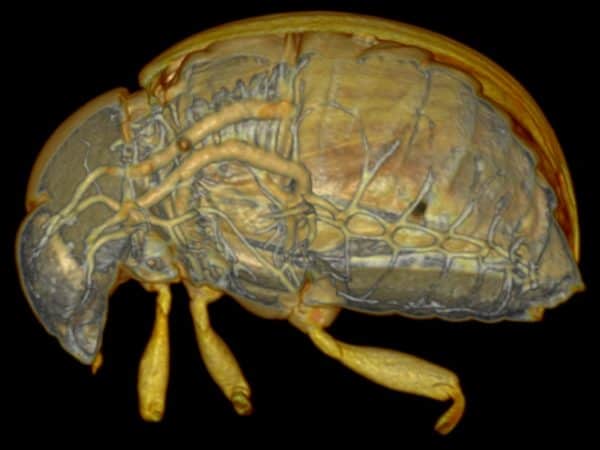New scanning technique let you see inside the organs of live insects

 Researchers at Western University in London, Ontario, have come up with a way to live-scan insects, allowing study of their internal body parts through 3D imaging. The new technique provides never-before seen access to life on a microscopic scale.
Researchers at Western University in London, Ontario, have come up with a way to live-scan insects, allowing study of their internal body parts through 3D imaging. The new technique provides never-before seen access to life on a microscopic scale.
The result of an interdisciplinary collaboration between an insect biologist and biophysicists with the University’s Imaging Research Centre in the Schulich School of Medicine and Dentistry, the story of the new process begins with one rule we’re all familiar with, either from personal experience or having seen it on our favourite medical TV show: you need to keep still when getting your brain (or any part of you, for that matter) scanned.
The same applies to insects, who unfortunately can’t be coaxed into remaining motionless while under an X-ray micro-computed tomography (micro-CT) scanner. As a result, imaging for entomologists has up until now been restricted to looking at the innards of already dead bugs.
Using carbon dioxide to live scan insects…
But now, using carbon dioxide to temporarily sedate their chosen specimens (Colorado potato beetles and true armyworms), researchers were able to create what have been called “spectacularly detailed, three-dimensional views” of tiny insects, a first in the field.
“I was absolutely awed,” said Joanna Konopka, PhD candidate with Western’s Department of Biology, in a press release. “I’m familiar with pictures and drawings in books but this gives us a wholly new perspective of what they are.”
The researchers made use of the fact that insects are known to be tolerant of high doses of ionizing radiation such as that given off by micro-CT scanning, along with being able to survive acute hypoxic conditions (being deprived of oxygen).
The induced anesthesia from the CO2 gas worked perfectly for the procedure, as it stop external movement of the body (twitching arms and legs) while also arresting heart beat and hemolymph flow (the insect equivalent of blood), thus eliminating the major motion-related problems for scanning.
The results show resolution to 20 microns, about five times smaller than the width of a human hair, and allow for clear views of the insects’ organs and reproductive systems.
“We have demonstrated that using CO2 gas during micro-CT imaging effectively induces safe, repeatable, whole-body, and temporary immobilization of live insects for 3D visualizations without motion artefacts,” say the study’s authors, whose research is published in the journal BioMed Central Zoology.
The researchers say that their results are a great example of interdisciplinary collaboration at work, combining the strengths of a biology lab with that of a medical lab. “This is the kind of thing that we’re supposed to be doing at universities: cultivating the scientific curiosity that says ‘what would happen if …?’ and then accomplishing something spectacular and, in many ways, unexpected,” said David Holdsworth of the Robarts Research Institute in the School of Medicine and Dentistry.
The Colorado potato beetle is a major scourge for farmers the world over and is considered the most destructive insect for potato crops. For the better part of a century, the wily species had been kept under control through the use of a variety of insecticides, yet over time the insect has developed resistance to virtually every major class of insecticide.

